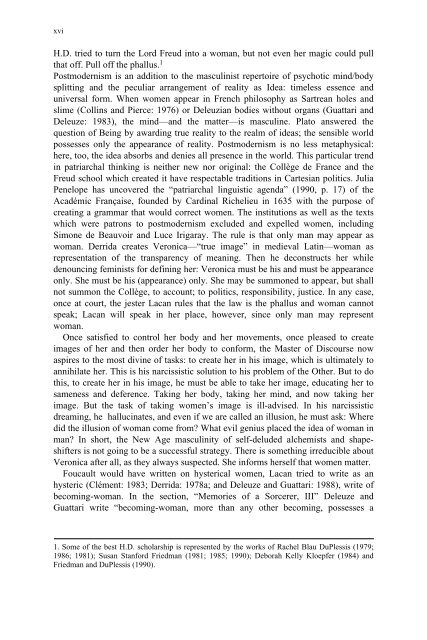Nothing Mat(t)ers: A Feminist Critique of Postmodernism
Nothing Mat(t)ers: A Feminist Critique of Postmodernism
Nothing Mat(t)ers: A Feminist Critique of Postmodernism
You also want an ePaper? Increase the reach of your titles
YUMPU automatically turns print PDFs into web optimized ePapers that Google loves.
xvi<br />
H.D. tried to turn the Lord Freud into a woman, but not even her magic could pull<br />
that <strong>of</strong>f. Pull <strong>of</strong>f the phallus. 1<br />
<strong>Postmodernism</strong> is an addition to the masculinist repertoire <strong>of</strong> psychotic mind/body<br />
splitting and the peculiar arrangement <strong>of</strong> reality as Idea: timeless essence and<br />
univ<strong>ers</strong>al form. When women appear in French philosophy as Sartrean holes and<br />
slime (Collins and Pierce: 1976) or Deleuzian bodies without organs (Guattari and<br />
Deleuze: 1983), the mind—and the matter—is masculine. Plato answered the<br />
question <strong>of</strong> Being by awarding true reality to the realm <strong>of</strong> ideas; the sensible world<br />
possesses only the appearance <strong>of</strong> reality. <strong>Postmodernism</strong> is no less metaphysical:<br />
here, too, the idea absorbs and denies all presence in the world. This particular trend<br />
in patriarchal thinking is neither new nor original: the Collège de France and the<br />
Freud school which created it have respectable traditions in Cartesian politics. Julia<br />
Penelope has uncovered the “patriarchal linguistic agenda” (1990, p. 17) <strong>of</strong> the<br />
Académic Française, founded by Cardinal Richelieu in 1635 with the purpose <strong>of</strong><br />
creating a grammar that would correct women. The institutions as well as the texts<br />
which were patrons to postmodernism excluded and expelled women, including<br />
Simone de Beauvoir and Luce Irigaray. The rule is that only man may appear as<br />
woman. Derrida creates Veronica—“true image” in medieval Latin—woman as<br />
representation <strong>of</strong> the transparency <strong>of</strong> meaning. Then he deconstructs her while<br />
denouncing feminists for defining her: Veronica must be his and must be appearance<br />
only. She must be his (appearance) only. She may be summoned to appear, but shall<br />
not summon the Collège, to account; to politics, responsibility, justice. In any case,<br />
once at court, the jester Lacan rules that the law is the phallus and woman cannot<br />
speak; Lacan will speak in her place, however, since only man may represent<br />
woman.<br />
Once satisfied to control her body and her movements, once pleased to create<br />
images <strong>of</strong> her and then order her body to conform, the Master <strong>of</strong> Discourse now<br />
aspires to the most divine <strong>of</strong> tasks: to create her in his image, which is ultimately to<br />
annihilate her. This is his narcissistic solution to his problem <strong>of</strong> the Other. But to do<br />
this, to create her in his image, he must be able to take her image, educating her to<br />
sameness and deference. Taking her body, taking her mind, and now taking her<br />
image. But the task <strong>of</strong> taking women’s image is ill-advised. In his narcissistic<br />
dreaming, he hallucinates, and even if we are called an illusion, he must ask: Where<br />
did the illusion <strong>of</strong> woman come from What evil genius placed the idea <strong>of</strong> woman in<br />
man In short, the New Age masculinity <strong>of</strong> self-deluded alchemists and shapeshift<strong>ers</strong><br />
is not going to be a successful strategy. There is something irreducible about<br />
Veronica after all, as they always suspected. She informs h<strong>ers</strong>elf that women matter.<br />
Foucault would have written on hysterical women, Lacan tried to write as an<br />
hysteric (Clément: 1983; Derrida: 1978a; and Deleuze and Guattari: 1988), write <strong>of</strong><br />
becoming-woman. In the section, “Memories <strong>of</strong> a Sorcerer, III” Deleuze and<br />
Guattari write “becoming-woman, more than any other becoming, possesses a<br />
1. Some <strong>of</strong> the best H.D. scholarship is represented by the works <strong>of</strong> Rachel Blau DuPlessis (1979;<br />
1986; 1981); Susan Stanford Friedman (1981; 1985; 1990); Deborah Kelly Kloepfer (1984) and<br />
Friedman and DuPlessis (1990).

















